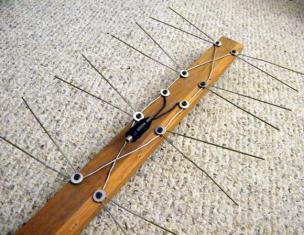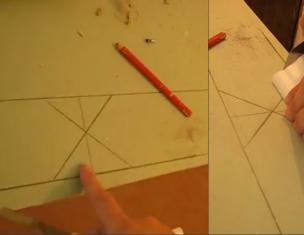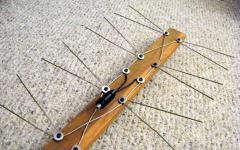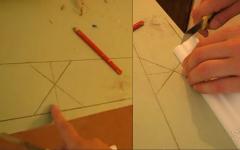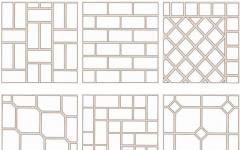Sharpening knives - the process is inevitable for any person. Despite the events of this procedure, many not only do not know how to sharpen a knife correctly, but also convey their "experience" to friends and acquaintances. It makes it possible that the correct sharpening knives is relevant only for blades from expensive steels, and a simple kitchen knife can be sharpened and a simple household sharpener for 200-300 rubles. You can actually sharpen before the sharpness of the razor you can, just on the knife with bad steel such a sharpening will last no more than five minutes.
Hand sharpening knives - the procedure is sufficiently long, which includes the use of natural abrasive stones and diamond bars. In order for the knife to brill her hair on her hand, it is necessary to "bring" it on the skin, using the GOI paste various numbers.
Choosing grinding stones for sharpening
The grinding bars for manual sharpening knives can be divided into four large groups, depending on the material that was used in their manufacture:
- Ceramic grinder bars;
- Diamond stones;
- Natural stones of natural origin;
- Japanese aqueous stones.
Brucks for sharpening the knives of ceramics are the most affordable way to sharpen your kitchen knives. Shelves of household stores and markets are filled with ceramic bars. They are several types. The most common is a "boat" bar. As a rule, it is very coarse and is suitable only for coarse sharpening or to change the angles of the knife sharpening. Often there are bars from Poland, having two sides, with a rough and smooth surface. This is the best budget choice. If the bar is erased, it is not sorry to throw it out and replace the new one.

Diamond bars are rarely used in professional sharpening knives. The sharpening process itself when using diamond bars is more complicated, and the cutting edge is quickly stupid. Diamonds often leave deep scratches on the cutting edge and "eat" too much metal when sharpening.
Natural stones for sharpening knives and Japanese aqueous stones are the best bars for sharpening knives. The big minus is their high price, often you have to order them from abroad.
The first criterion on which it is worth focusing when choosing is the size of the bar. Its length should exceed the length of the knife blade of 1.5-2 times. The surface of the bar for sharpening knives should be smooth, without chipping and cracks. If the stone is damaged, it is better to give up the purchase.
For sharpening kitchen knives, ceramic bilateral bar, or several bars of different graininess, production of the USSR. No matter how the Soviet industry did not scold, the grinding stones in the USSR were made strictly according to GOST. Unfortunately, now such bars can only be found on flea markets.
If your task is not just incident to the kitchen knives, and you want to sharpen hunting or tourist knives to the state of the razor, then buy a goe paste, for finishing polishing the cutting edge.
Choosing grit grinding bar
Grinding stones accepted to divide into three categories:
- Rough grain
- Medium grain;
- Small grain.
Do not everyone know that in addition to this, they are divided like slightly sandpaper in terms of the amount of abrasive grain on the conditional unit of the square. Bruks start with marking 100 and ends at about 15,000.
Usually, at sharpening, the bars 600-800 units are used. For polishing the edge applies labeling bars 1500-2000. Bruks More than 2000 are used only by professionals and are rarely on sale.
Step-by-step instructions for sharpening a knife

Before starting the knife, you need to understand several rules for yourself:
- The knife sharpening angle must be strictly set aside;
- It is not necessary to strongly press the knife when sharpening, it does not sharpen faster, but the grinding stone can be damaged;
- Sharpening bars should be washed with water for cleaning from metal dust.
If you try to sharpen the knife for the first time, you should not train on expensive models, take a simple kitchen knife and bring it to the sharpness of the razor.
- First of all, it is necessary to rinse the bar with water with a soap solution or a dishwashing agent;
- The second stage is the preparation of the workplace. To do this, a straight board is put on the table, which is installed for a grinding stone. The position of the bar each chooses the convenience in its feelings;
- Before you begin sharpening, you need to choose, at what angle you want to sharpen the blade. It should be remembered that for thin work the sharpening angle should be about 20 degrees. For a universal knife, 30-40 degrees will come up. The choice of sharpening angle directly depends on the quality of steel on the knife blade. High-quality steel is capable of keeping a thin sharpening. To accurate cheap kitchen knives at a small angle inappropriate;
- The essence of the installation of the right corner of the blade is that the cutting edge is perpendicular to the movement of the knife on a sharpening bar. If the angle of the knife is satisfied before sharpening, it is not difficult to withstand it, the cutting edge is simply pressed against the bar with the whole surface. To change the angle of sharpening, it is better to use special fixtures to hold sharpening angle. They can be purchased in specialized knife stores or make themselves;
- Fixing the blade at the desired angle, we start sliding the blade on the bar from ourselves. The blade is sharpened before the appearance of the "burr" along the entire length of the cutting edge. When it appears, you can go to the sharpening of the other side of the knife. The dust appearing during sharpening should be periodically rinse under water stream;
- After sharpening on rough abrasive, you can move to the closer on the smaller stone. The procedure for such a refinement is no different from sharpening on a rough grinding stone. If you have several stones with smaller graininess, continue sharpening by changing them from smaller in more;
- For a kitchen knife, such sharpening will be enough, it will finely cut the tomato and paper. If you want to achieve a razor sharpening of the blade, you should polish the RK (cutting edge) on the skin with the paste of the goy;
Bringing the cutting edge to razor sharpness

For "RK's adjustment, a special polishing paste GOI is used, designed during the existence of the USSR by the State Optical Institute. Pasta is flawed on a piece of leather, which is desirable to attach to a wooden bar, the size of a standard grinding stone. The polishing feature on the paste of GIO is that the blade of the knife must be grinding the movements on themselves.
Sharpening of Japanese knife
The sharpening of the Japanese knives passes according to a special scheme, since the blades of Japanese knives have different geometry and one-sided sharpening. Such geometry leads to the fact that the products do not stick to the blade of the knife.
Japanese blades are sharpened by the same abrasives, like other types of knives, they only appear on the one hand before the appearance of a burr. When it appears, the blade turns over the other side, and the burr is removed by several movements. After that, the grinding stone is replaced by a stone smaller grain, and the procedure is repeated.
Household hand sharpeners for knives
There are many small kitchen sharpeners, the manufacturer of which assures that they can perfectly sharpen a knife in one minute. In fact, these sharpeners can be recommended only to someone who wants to get rid of a knife in a short time. These sharpeners "eat" a large amount of metal, and soon the knife becomes thin and unsuitable for further operation.
There are excellent fixtures for sharpening knives that not only can sharpen your knife before the sharpness of the razor, but also allow you to easily withstand or even change the cry of the blade sharpening. These are EDGE Pro Apex or Lanski type systems. The machine for sharpening knives is quite expensive, about 6,000 rubles.

There are also analogues of the Chinese company Ganzo, which are two times cheaper. The machine for sharpening the knives of this manufacturer has proven itself well.
Typical errors when sharpening knives

People who are not experts in the field of sharpening knives often admit gross errors in this process:
- Having bought one first barn, believe that this is enough for a full sharpening. In fact, the set for sharpening knives at least should include several bars of various grainies;
- Husbanding knife. During sharpening on the cutting edge, a knife is formed by a lot of small burrs, which can create a feeling that the knife is shared. Such burrs quickly laid out in the course of operation with a knife, and it is necessary to drag it again. In order to avoid such a situation, you need to carefully examine the RK in the sharpening process;
- Some start sharpening, even without twisting the knife from dirt and fat, seeing how professional cooks rule their knives to the Mussate in the process of cooking. It is necessary to remember that the Mussat is intended only for editing the cutting edge, it does not sharpen a knife blade;
- Do not strongly press the knife to the bar during sharpening, that you will only spoil the grinding stone;
- Wrong sharpening angle. It must be remembered that too much sharpening angle will not allow your knife to finely cut down products, and with a small coal sharpening the blade quickly "sits" on solid products.
When sharpening, just follow these uncomplicated rules, and everything will turn out.
Device for sharpening knives with your own hands
If someone does not suit the high price of the branded appliance for sharpening knives, then you can make the installation with your own hands. A plus of self-making is that you can make a set for sharpening knives taking into account your wishes by changing the design in any direction.

To start work, you need to find a suitable drawing on the Internet. Usually homemade sharpeners are two types:
- Simple sharpener type LANSKI;
- Homemade sharpener, like the model from EDGE Pro Apex.
What model to copy, solve you, only one should remember that the first option is simpler in the manufacture, but less convenient for use. The set for sharpening the knives of the second type is technically more difficult, but it is much more convenient to work on it. We will look at how to make a simpler option.
Manufacturing Sharpeners type LANSKI
For the manufacture of chickens of type LANSKI, you will need a grinding stones of different grainies, a piece of thick plexiglas, from which cut holders for stones, aluminum corner, thin steel bar and aluminum profile.
For a start from the plexiglass, blanks are cut for sticker abrasive stones. They should be a little longer than the grinding bars, as they still have to drill holes in them in order to insert the rods there. A pre-curved letter "g" bar is inserted into the drilled holes and fixes the fixing bolt.
From the aluminum profile and corner you need to cut several blanks to make the clamping system for a knife later. At the top of the assembled design, do not forget to drill several holes for various angles of sharpening by analogy with the LANSKI system.
Do not forget about the manufacture of the rack to consolidate the entire design in a fixed position. You can do without it, but it will create great inconveniences in the work.
Set for sharpening knives in hiking conditions
Naturally, in the campaign it will not be possible to take a full set for sharpening knives with you, but double-sided stone and a strained leather bar is preferably put in a backpack. Let the steel on your knife possess outstanding characteristics, nobody is insured against the chosel and the cutting edges of the cutting edge. It will be problematic to put a bouquet knife or a knife from powder steel, so take a small carbon steel knife, it will not take a lot of space, but it will help you in case of failure of the main knife. Carbon steel has a very aggressive sharp and easily sharpening on a simple grinding stone in a couple of minutes. At the same time, such knives hold quite well sharpening. The only minus is insufficient corrosive stability of such steel.



